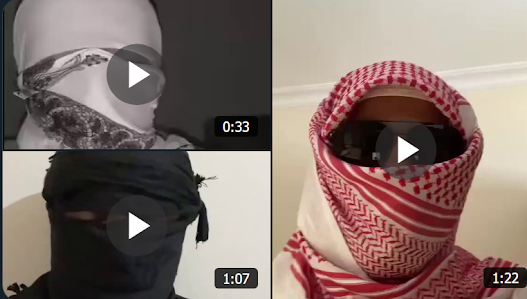We Must Consider All Possibilities Regarding the Free Masked Ones Movement
We Must Consider All Possibilities
Regarding the Free Masked Ones Movement
If we assume good faith, we might consider the movement as a spontaneous, individual initiative, a reflection of isolated acts by frustrated youth who are not connected to each other in any organized way.
However, concerns remain about the timing of its sudden emergence, followed so quickly by a shift toward the rhetoric of armed struggle and claims of a fully-formed military organization on the ground. That is why we should not rule out any alternative scenarios. This is not about casting suspicion, but rather about exploring all plausible explanations before reaching any conclusions.
What follows is an imagined dialogue between Mohammed bin Salman and the U.S. administration, intended to help us understand why the Saudi government might fabricate or manipulate an armed group. Some elements of this conversation may, in fact, reflect discussions that actually took place behind closed doors:
Mohammed bin Salman and his aides have been persistently calling for a “Comprehensive Protection Treaty” with the United States.
Americans: What are the justifications?
Saudis: To counter the imminent threat from Iran and their allies, the Houthis.
Americans: But you’ve already established friendly relations with Iran, thus Iran is unlikely to encourage the Houthis to act against you. Following the reconciliation brokered by China, this justification no longer holds. Moreover, the Houthis haven’t attacked you or violated your territory, in fact, you were the aggressors. Despite having the capacity to strike your vital infrastructure, they have refrained. So again, who exactly is this protection treaty meant to defend you from?
Saudis: From opposition figures abroad.
Americans: Your opposition abroad is minimal, scattered, and riddled with egoism. Their ability to organize or mobilize internally is almost nonexistent. Their influence inside the country is marginal and poses no significant threat.
Saudis: We want protection for the royal family from any possible internal uprising or terrorist group.
Americans: There are no signs of a revolution. You’ve eliminated extremism and so-called extremists with the stroke of a pen, and let’s be honest, you created them in the first place. As for Al-Qaeda and ISIS, many now understand who really stood behind them. Let’s not deceive each other. Moreover, you’ve imprisoned tens of thousands under the banner of fighting extremism and terrorism. We cannot support this and demand the immediate release of those with no connection to violence, weapons, or incitement.
End of the imagined dialogue.
It may be after such a dialogue that the idea of the #Free_Masked_Ones_Movement was born. It appeared suddenly, out of nowhere. Within a week of the first masked individual’s appearance, another emerged in a video claiming the existence of a fully armed and structured organization, an effort to "prove" the existence of an actual security threat.
Regardless of whether this conversation truly occurred, it remains a fact that authoritarian regimes often resort to manufacturing or manipulating violence. They may even create fictitious groups that allegedly threaten public security in order to justify repressive campaigns and give their crackdowns a veneer of legitimacy under the pretext of protecting national stability.
This is precisely what the Algerian military did when they overturned the 1992 election results and established a full-fledged repression strategy. This same approach was later gifted to the Assad regime, which used it to crush the Syrian uprising in 2011, as documented in numerous reports and records.
Today, after reconciling with both Qatar and Iran, and with the cards of the “Muslim Brotherhood” and alleged terrorist groups like Al-Qaeda and ISIS having lost their effectiveness, the regime needs a new internal enemy, one that justifies a renewed crackdown. The Free Masked Ones Movement could be that convenient scapegoat, allowing the state to arrest disaffected citizens and unemployed youth under vague accusations of affiliation with a covert armed group.
So, we arrive at the following possibilities regarding the movement:
1. A spontaneous, individual response, driven by frustrated youth suffering from joblessness, humiliation, and delays in receiving social assistance, while seeing no opportunities for personal progress or marriage.
2. Partially infiltrated by the government, in which the state inserts its own agents who claim to be part of a fully armed wing engaged in surveillance, intelligence gathering, and armed confrontation. This serves to tarnish the movement’s image and justify treating it as a field-based threat to state security and stability, paving the way for arrests both domestically and internationally.
3. Entirely fabricated by the government, a fully artificial group invented to simulate a domestic threat, enabling the regime to launch a wide-ranging crackdown under the guise of preserving stability.
Therefore, it is best to share news of the movement and express support only for its legitimate, peaceful demands. If it is genuine, such support will help amplify its voice without harming its cause. That’s what any sincere grassroots movement desires. But if it is merely a state-engineered deception, then peaceful support cannot be used as a legal or moral justification for persecution, neither inside the country nor abroad, under the pretext of aiding or affiliating with an armed group.
And God knows best.




تعليقات
إرسال تعليق
تسعدني قراءتك وتفاعلك مع المقال